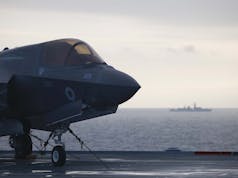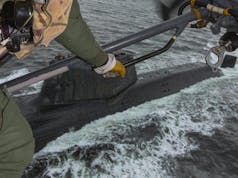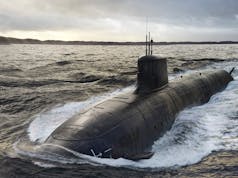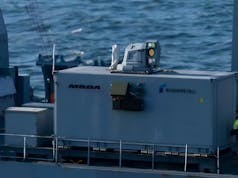It has been reported that MBDA has been selected to demonstrate British laser weapons for use on Royal Navy warships.
The company was reportedly selected last week according to DefenseNews and IBL and is due to be confirmed as the winning bidder in the next few days.
It had been speculated that the MoD was due to select a contractor to build a technology demonstrator to validate a laser weapon system.
It is understood that the laser would be ‘co-mounted’ with the Phalanx’s cannon, rather than replacing it altogether.
Raytheon, a rival bidder, had showed a possible configuration with a laser and the 20mm Phalanx fitted alongside a radar and optronics. This image is shown above.
The Royal Navy already widely uses the Phalanx across its fleet.
According to multiple reports, the Royal Navy would add to its stock of Phalanx by purchasing additional weapons at some point. Close-in weapon systems remain a shipboard necessity for detecting and engaging missiles and aircraft at short range.
This news will see Britain join the laser arms race after America has already deployed a laser to the Gulf on one of its own warships.
Former First Sea Lord, Admiral Sir George Zambellas, made an announcement foreshadowing this last year. He claimed that Britain will test a prototype laser cannon on its warships by the end of the decade.
The “directed energy weapon” will be able to fire high energy beams to damage and burn up targets at the cost of only pence per shot.
America deployed a working laser weapon system on board USS Ponce in the Gulf last year. The laser has been successfully tested shooting down drone aircraft and burning up small attacking boats, or at lower power to “dazzle” sensors and instruments. The AN/SEQ-3 Laser Weapon System reportedly worked perfectly, indeed the commander of the Ponce is authorised to use the system as a defensive weapon.
Laser weapons are an increasing focus for defence firms and expected to become more common on the battlefield in the next decade.
In May, Raytheon claimed the first test firings could take place in 2018.













FRICKIN LASER BEAMS
About time, a lot cheaper and more effective in some situations
Burning holes in slow, black, rubber inflatable, dinghies in perfect weather on a calm sea.
Uh huh. Colour me impressed.
Bet it will be a rating with a laser pen on the upper deck. Trying to fool Russians. Like us on Ark 1988on Outback 88 Deployment painting broomhandles navy gray and masking tape to upper deck. Russians very confused with all our new communication systems.
Confusing the opponent is SOP. Confusing him cheaply is even better. This is proof that laser weapons won’t happen, how?
Awasoooooom
Pew Pew indeed 🙂
point it anywhere near a heli or plane and the solicitors will be thinking all their christmases have come at once lol
Can we have sharks with lazers
A PHASER!!
Effective at interference with laser guided incoming, but just can’t see anything with the punch power to overcome atmospheric absorption at any distance. Still the work never stops.
We have Phasers already OSA prevents me from giving more details
We will also have underwater drones that look like dolphins with passive sonar 3009 and uranium tipped miniature ultra high velocity torpedoes the size of a 50 cal shell
Charlie Stuart
Pew pew pew
Meh. We had it first. :p
Now, if the Royal Navy wouldn’t mind changing uniforms to something in a nice OD green, with tall boots, and built their ships in a more triangular shape with more lasers… then you guys could pull ahead! 😉
Shahzad Nayeemuddin
Nice idea…. Unless it’s a bit cloudy…… Oh dear.
Those lasers are better than the phalax guns that protect against anti ship missiles ect the now.
Need a very large generator
what warships !!!!!?
On which ship will they be put on … what fantastic news
FRIGGIN LASERS
It’s always great to go to the comments section and see your witty reply is already the top comment.
Lol if putting a kettle on for a cup of tea causes a t45 to break down what will these do hahahaha
My thoughts exactly
Great for having techno festivals at Portsmouth providing the light shows. They won’t be going anywhere else 😀
Matteo Ferrera
a little bit early for that kind of technology if you ask me.
Thanks for letting us know. I’ll be sure to let the MoD and dstl know
Lasers have been around as weapons since the 1960s and nowadays they are highly efficient weapons
Been tried and tested. They work.
The future is here ??
That’s fine but the gun will only be 5 inches tall!!
Arran Cooper
I thought due to international law “blinding” weapons were outlawed
Can’t blind a drone or an aircraft but you can burn with a laser beam
But you can blind a pilot in an aircraft, a burning weapon is the the same as a blinding weapon? I’m not trying to be facetious it’s a genuine question?
The Protocol on Blinding Laser Weapons, Protocol IV of the 1980 Convention on Certain Conventional Weapons does ban lasers specifically designed to blind though this does not apply to incidental or collateral blinding.
These lasers are intended for close in defence against missiles and drones. They are colocated with the Phalanx which would deal with manned aircraft that get through the other layers of defence.
So when’s Death Star being built ?
Rail guns yes, effective laser weapons? Not yet.
I’d say this is effective …
https://m.youtube.com/watch?v=gBuiPZm6hK4
Actually what I have read,its other way around.the lasers are now been used by u.s.,but the rail guns are not.they have stiland problems.so far what I have read it says that the barrel of the railgun can only be used a few times cause they tend to break.I not just sure if they already solved the problem
Can I just point out that these lasers are for air defence and limited surface defence.they are designed to burn holes in aircraft or drones
??????????????????
Sod being the maintainer for that !!
^ clap for Simon ??
It’s basically a Chinese laser pen bought from eBay mounted in an old technics speaker. The bin in the middle is so you can recycle the batteries
Looks like r2d2 with disco lights to me
Would that take lot of power to shoot down targets and time
That will break all the time.
Good move, be sure to have some r&d on the tech as well. 🙂
They use lasers on USS Ponce.
[…] July we reported that MBDA had been selected to demonstrate British laser weapons for use on Royal Navy […]
[…] July we reported that MBDA had been selected to demonstrate British laser weapons for use on Royal Navy […]
[…] to fire high energy beams to damage and burn up targets at the cost of only pence per shot,” reported the UK Defence […]
[…] high energy beams to damage and burn up targets at the cost of only pence per shot,” reported the UK Defence […]